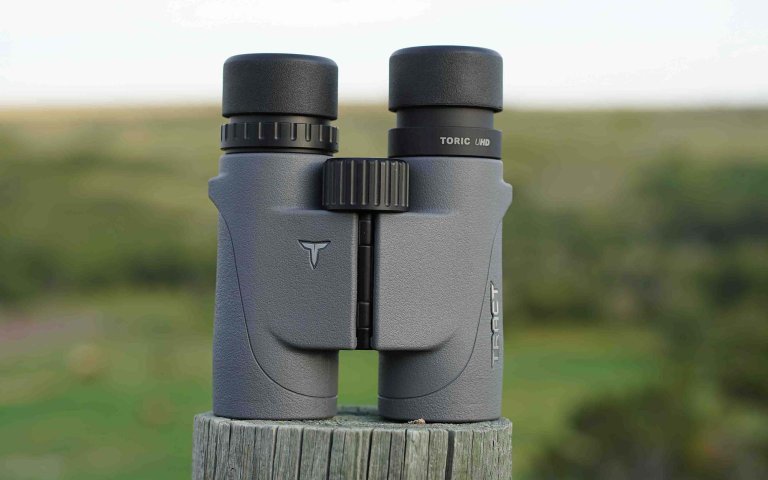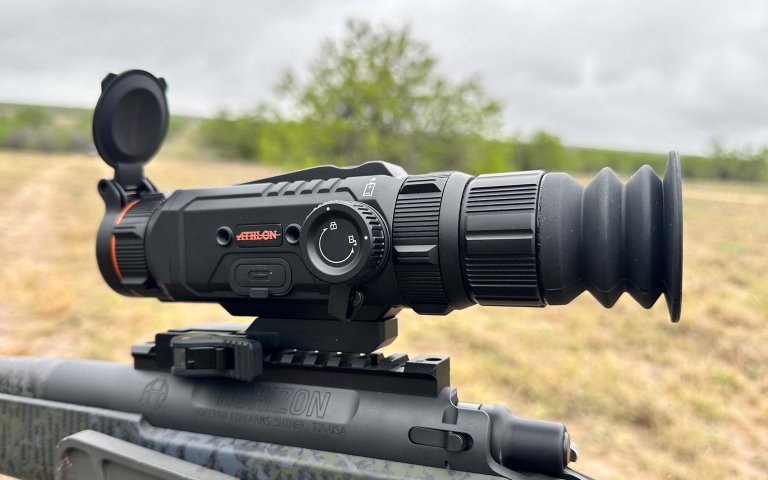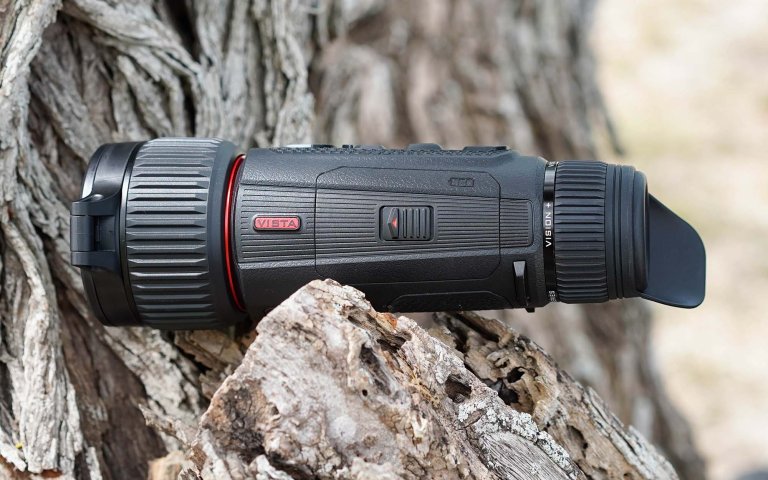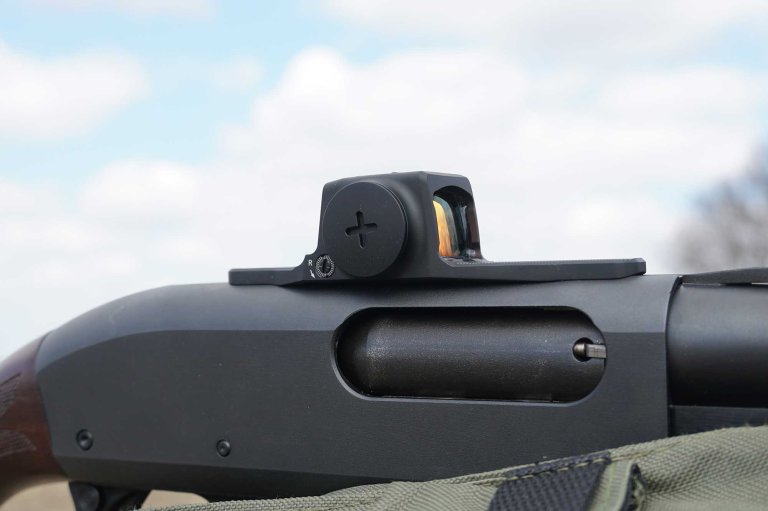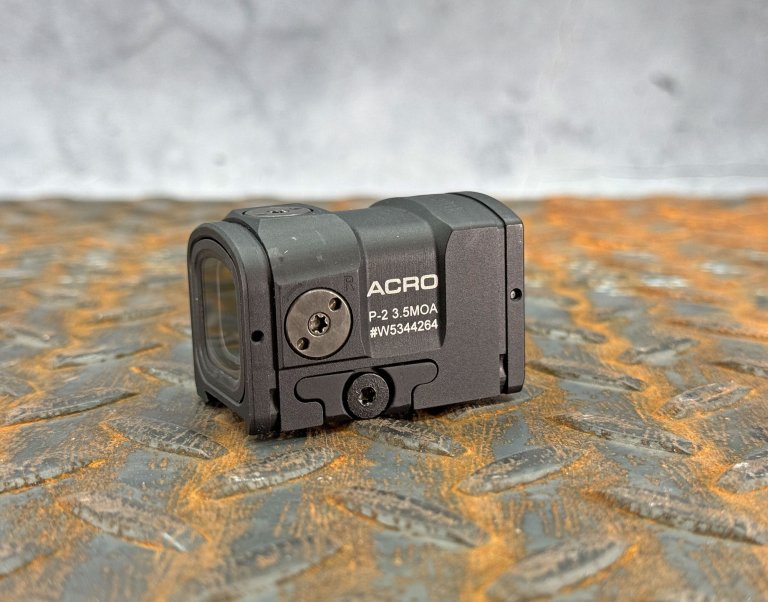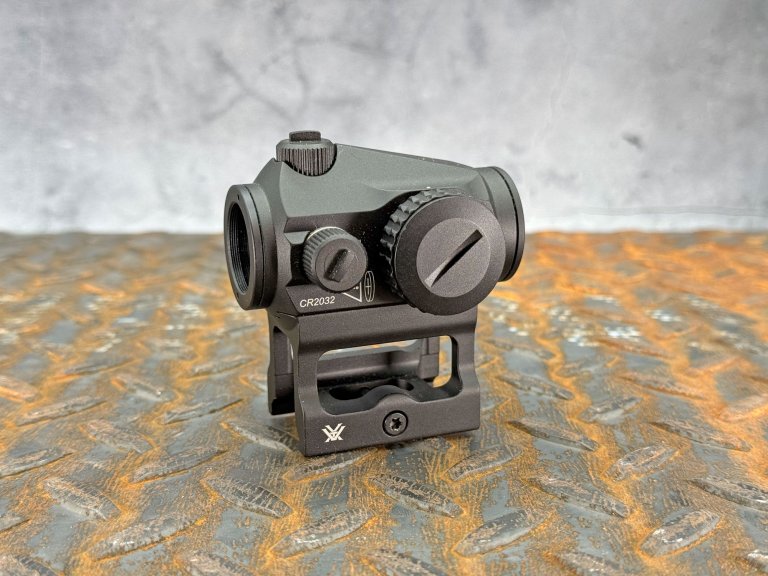In addition to our sporting optics tests we also evaluate thermal optics and red dots for a variety of platforms. Here are the winners form those gear tests.
Introducing The Real Grit, our retail partner for the 2025 Field Tested Awards. Buying through the links provided helps support Outdoor Life.
Best Value Binocular: Tract Toric UHD 8×32
Pros
- Tight and durable build
- Bright Schott high-transmission glass
- Light at 23 ounces
- Easy one-hand operation
- Tight and positive controls
- Lifetime warranty
Cons
- Relatively expensive for a compact bino
- Slight blue edge aberration
Key Features
-
Closed-bridge design Locking right-barrel diopter -
Front-hinge ¼-20 tripod thread -
Magnesium-alloy chassis -
3-position eyecups -
Easy one-hand operation
Calm down, settlers. I hear your roars of discontent that we have named a $644 compact binocular an Outdoor Life Great Buy. That’s a lot of money for relatively little glass. But hear me out. First, there wasn’t a lot of competition for the award this year. There were cheaper submissions, but they were optically inferior to this bright, tight little unit. And this binocular from a direct-to-consumer company punches way above its size. Add the lifetime warranty and versatility from whitetail stands to turkey vests to every truck console in America, and this is the binocular you will reach for above all others.
We’ve tested the big brothers of the 8×32 in previous tests, but this configuration hits a sweet spot. Its image seems like it was delivered by a big 10×42, but the small frame of the 8×32 fits in places the larger chassis doesn’t.
Then there’s the tight build of the Toric. Those who have followed the evolution of Tract Optics know one of its distinctive features is smooth, positive, extremely tactile controls. Scope turrets move with smooth precision and binocular eyecups feel like they glide on ball-bearing races. Those controls extend to the focus wheel, locking diopter control, and eyecups of this smallish binocular.
The detail that cemented the Great Buy award for the Tract Toric is its lifetime warranty. I doubt you’d ever use that coverage, but it’s useful to know that you have a binocular for life. In the field, you’ll use it for a one-handed spot-and-stalk bowhunting optic. You’ll have it in your bino pouch for turkey hunting or hiking. Or you’ll throw it in your luggage for a travel optic.
Testers subtracted points for a fairly clunky build and some blue color fringing. Testers who gravitate toward full-sized 10×42 binos thought the compact Tract was underwhelming.
“My first impression was that I didn’t want to like this binocular,” noted tester Ky Idler. “But surprisingly it fit my hands. Good glass. It would be a very good spot-and-stalk binocular.”
The Tract seems bigger than it is largely because of its excellent glass. It’s built around high-transmission Schott glass, manufactured in Japan, and has a wide field of view. Normally, I like open-barrel designs for one-hand operation, but the closed-bridge build of the Toric, while a little center-weighted, has enough heft that it settles in hand, whether one hand or two.
I’d readily use this binocular for bowhunting, when single-hand operation is required and where positive focus control helps parse close, medium, and far range targets. The Tract capably handles this chore with aplomb, if not distinctive style.
Maybe this helps answer the question: Is $644 too much to pay for a quality compact binocular? In the case of the Tract Toric UHD, the answer is decidedly no. While I’m not eager to pay more, this is a solid deal for a very good and versatile hunting optic.
| Tract Toric UHD 8×32 Specs | |
| Magnification: | 8-power |
| Objective Lens: | 32mm |
| Light Transmission: | Not provided |
| Exit Pupil Diameter: | 4.0mm |
| Twilight Factor: | 16 |
| Field of View: | 424 feet at 1,000 yards |
| Close Focus: | 6.5 feet |
| Weight: | 23 ounces |
| Length: | 5.2 inches |
Best Spotting Scope: Leica APO-Televid 82 Kit 25-50×82
Pros
- Stunning image
- Dual focus control
- Removable eyepiece
- Compatible with 20-60x eyepiece
- Redesigned optical system
Cons
- At over $4,000 with eyepiece, wildly expensive
- At 3.3 pounds, fairly heavy
Key Features
-
Angled eyepiece -
Durable die-cast magnesium body -
Arca-Swiss compatible mounting foot -
Aiming slots on sunshade for quick target acquisition -
Coarse and fine focus wheels
You owe it to yourself to look at the world through this heirloom-quality optic. Then you can literally see the dilemma of the Outdoor Life optics testers. This $4,000 spotter was bound to win our test based on the world-class glass, European craftsmanship, and Leica’s legacy of optical excellence.
The dilemma: Is a $4,000 spotter really four times better than a $1,000 spotter? Keep that question in mind as you read our results. But in terms of the 82mm Leica APO-Televid, it’s one of the finest spotters we’ve tested, and is a worthy candidate for inclusion in the highest level of sports optics, to include Zeiss’s Harpia 82, Swarovski’s Optik HD, and Kowa’s Prominar spotters.
The Leica’s glass is bright, crisp, and vibrant, though it actually struggled a bit in our low-light test, finishing in the upper middle of the field. Because we also tested the 65mm version of the APO-Televid, which came with a 20-60x eyepiece, we swapped eyepieces between the two scopes and found the 82mm Televid at about 40x had the best combination of optical clarity, brightness, and field of view.
The Televid’s operation is flawless, with double points for its dual-speed fingertip focus. Turn the coarse focus to get in the ballpark, then tack up the focus with the fine wheel, which turns so easily and positively that it doesn’t impart any shake to the tripod.

The scope mates to tripods easily with its Arca-Swiss-compatible foot, and the balance is nicely centered for such a heavy (4.25-pound) scope. We also like the simple but effective aiming slots in the sunscreen that help users quickly acquire targets through the angled eyepiece.
We used a very handy smart-phone adapter to capture loads of photo and video content through both the Leica scopes. The Ollie adapter is among the best we’ve seen, with a quick and sure magnet that mates the eyepiece adapter to the phone case, aligning the phone’s camera with the exit pupil of the scope. It’s a fast, simple, and very effective way to record content through any scope.
The only demerits we gave the Leica Televid is its price. As tester Luke Coccoli noted, “I would hate to take it out of its case for multiple uses at that price point. It’s as close to a perfect spotter as I’ve seen. But it’s also $4,000.”
Still, it’s a great investment in a world-class optic that pays dividends by delivering bright, crisp, and stunning images from as close as 12 feet to as far as you can see.
| Leica APO-Televid 82 W with 25-50x Eyepiece Specs | |
| Magnification: | 25-50-power |
| Objective Lens: | 82mm |
| Eyepiece: | Removable angled |
| Focus Control: | Two-speed fingertip |
| Construction: | Die-cast magnesium |
| Exit Pupil Diameter: | 3.3mm to 1.6mm |
| Twilight Factor: | 45.3-64 |
| Field of View: | 123-84 feet at 1,000 yards |
| Close Focus: | 12.5 feet |
| Weight: | 67.9 ounces with eyepiece |
| Length: | 15.3 inches with eyepiece |
Best Thermal Scope: AGM Adder V2-60
Pros
- Shot-activated video recording
- Integrated ballistic calculator
- Best display resolution in class
- Internal/external battery dual-power system
- 9-plus hour run time
- Top-turret operation is fast and simple
- Rounded display resembles traditional daylight scope
- Red and green monochrome palettes reduce night-blindness
- Ships with 30mm ADM Recon Mount
- Extremely easy to zero
- 5-year warranty
Cons
- At over $7,000, wildly expensive
- Unexpected shut-downs with battery drain
The future of thermal hunting is here, and it’s gonna cost you. The new 1280-class Adder V2-60 from AGM Global is bright, clear, sensitive, and fully capable of making range-adjusted nighttime shots out to 1,000 yards. The price for that performance? An eye-watering $7,300.
Anyone who has ever used a thermal scope has wanted it to perform like a daylight scope. But the technology that converts temperature variation into visible images is so full of noise and distortion, from the processor to the software that sharpens images to the digital screen that projects them to your eye, that thermal hunters have to accept headaches, eye strain, and astigmatism as a price for seeing into the night.
The V2-60 is the closest I’ve come to a thermal scope that delivers an image that’s in the same galaxy as that of a traditional scope. It achieves that performance with a souped-up 1280×1024 sensor, one of the most powerful in the class, and a high-resolution 2560×2560 digital display that is crisp and contrasty. But it’s AGM’s software that fuses these components into an almost pleasing image.

Add a blazing-fast 1,000-meter through-the-lens laser rangefinder, cold-and-warm viewing modes that reduce eye strain, an on-board ballistic calculator that displays distance-adjusted holdover, and a 9-hour run time, all packed in a fairly trim 30mm aluminum tube.
All that performance combines to make the AGM Adder V2-60 the consensus winner of our Editor’s Choice as the top thermal scope of the year.
But there’s more. Two features of the Adder that may get lost in its specs include a ½-power magnification step. Most thermals have what’s called “step zoom,” in which the magnification doubles with every tap of the button. Those big steps can create large gaps in the zoom range, but the Adder’s incremental zoom creates a much more usable magnification range. Second, that 1-inch hyper-sharp display is slightly rounded, giving users the visual perception of looking through a traditional scope.
The AGM wasn’t without its flaws. Tester Alex Robinson struggled with unexpected shut-downs.
“When the external battery was low, but the internal battery was full, the scope shut off repeatedly,” he noted.
The AGM had hot competition from Nocpix’s new 1280-class ACE S60R scope and Pulsar’s Thermion 2 XL50. On paper, the Nocpix has the more impressive array of features. But here’s where the power of image-enhancing software tips the scales. In head-to-head-to-head comparisons, testers unanimously noted that the Adder had the clearest and least eye-straining image. That’s a squishy but important consideration for thermal users who might be behind their scopes for hours at a time.
Still, there’s the issue of the high cost of the AGM. Readers who aren’t immersed in the realities of thermals might be put off by the price. But readers who know that, just as with traditional optics, with thermals, generally, the more you pay, the more you get. That’s certainly the case with the remarkable, full-featured, investment-quality AGM Adder V2-60.
| Thermal Sensor | 1280×1024 |
| Display | 2560×2560 |
| Pixel Pitch | 12-micrometer |
| Sensor Sensitivity | 18mK |
| Frame Rate | 25Hz |
| Magnification | 2.5-28x |
| Objective Lens | 60mm germanium |
| Rangefinder | 1,000-meter detection range, through the lens laser |
| Image Storage | 32GB on-board |
| Price | $7,345 |
Great Buy Thermal Scope: Athlon Cronus ATS Pro 25P-250
Pros
- For around $700, a bargain
- 9-hour run time with internal and external batteries
- Includes single-point QD rail mount
- Single-button and rotary selector operation
- At 8 inches, perfect for carbines
- Easy to zero and calibrate
Cons
- Power/selector button is finicky
- Battery cap hard to keep closed
- Underwhelming clarity
- Clunky mobile app
Let’s start with what this entry-level thermal isn’t. It isn’t very clear or very sharp. It isn’t going to allow you to shoot out to 500 yards, or even past 250 yards. It isn’t going to win any hunting competitions or design awards. It feels a little flimsy.
But it is one of the best bargains in the thermal market, and is fully capable of getting you on coyotes and pigs out to near 200 yards. It will easily capture video and photos and transmit them to your phone. It comes with a solid rail mount. It’s easy to operate. And it gives hunters an opportunity to dip their toe in the thermal category without taking out a second mortgage.
Given the astonishing capabilities – and prices – of its competition, we had low expectations of the Athlon. The ATS Pro’s 256-microbolometer sensor is among the lowest-resolution cores in our test. To put that in context, the 1280-microbolometer sensor of AGM’s Adder has five times more resolution. It’s also 12 times more expensive.

The $600 entry point for the Athlon Cronus ATS Pro 25P-250, combined with its decent performance, is what makes it so appealing, and what earned it our Great Buy award for the highest Price/Value score in the group.
If you want a bit more resolution, consider Athlon’s Cronus ATS Pro 35P-400, with a 400×300-pixel core. That unit will cost you about $1,000; in our view the increased performance doesn’t quite justify the upcharge.
The 25P-250 Cronus isn’t racing for the bottom. Its one-button and rotary selector operating system is fast and intuitive. Double-tap the power button to reveal the menu, use a rotary collar inside the eyepiece to navigate its options, then hit the power button to make selections. The scope has 10 selectable reticles, five based on MOA and five based on MIL dimensions adjustments, and seven color palettes. While the Athlon doesn’t exactly have a ballistic calculator, it does have the ability to customize reticles to various holdover values at specific distances.
Athlon’s mobile app is a little clunky — among its other shortcomings, it only works in horizontal mode — but the photo and video transfer is easy.
The single-point rail mount is decent, and makes for fast mounting, but it’s not a precision attachment. We also had fits keeping the battery cap attached. That’s a small quibble, but a meaningful shortcoming since it reduces operating time. And we worried that the plasticky build might not be up to the sort of bump-and-grind abuse thermal hunters routinely demonstrate.
But those are speculative fears. What we determined in testing is that this is a thermal that’s absolutely worth the money.
| Thermal Sensor | 256×192 |
| Display | 1024×768 OLED |
| Pixel Pitch | 12-micrometer |
| Sensor Sensitivity | 30mK |
| Magnification | 3.6-14.4x |
| Power | 1 internal battery, 2 rechargeable 18500 batteries |
| Reticles | 10 reticles, 7 color palettes, pre-set holdover values |
| Price | $599 |
Best Thermal Monocular: Nocpix Vista H50R Thermal Monocular
Pros
- Communicates with other Nocpix devices through N-Link connection
- Extremely high-def display Image-stabilization feature calms images
- Sensitive and powerful laser rangefinder
- 5-plus hour run time
Cons
- Images are heavily filtered
- Viewing display is like looking down a narrow tube
Key Features
-
640×512 thermal sensor -
2560×2560 AMOLED display -
12-micrometer pixel pitch -
15mK sensor sensitivity -
60Hz frame rate -
4x base magnification -
2,400-yard detection range -
1,200-yard thru-lens laser rangefinder -
64GB on-board image storage -
Price: $3,499
One of the surprises of the test was the overall satisfying performance of this sharp, bright, and reasonably priced 640-class monocular from what can best be called a new heritage brand (more on this below). The Vista H50R sits in the upper middle of the Vista family, sporting a very useful laser rangefinder and 50mm germanium objective lens but powered by a fairly standard 640×512 thermal sensor. Nocpix’s flagship Vista S50R contains the brand’s new and powerful 1280×1040 sensor but costs around $5,200.

The Vista H50R, with a 4x base magnification and 10-times zoom to 40x, surged to the front of the test lineup by doing a number of things extremely well, from precise ranging with its through-the-lens laser rangefinder, which keeps its form factor streamlined, to its easy connectivity to the very good Nocpix mobile app, to its easy-to-navigate menu.
A noteworthy detail is its vivid, high-resolution display, one of the best in the test. It’s a 2560×2560-pixel AMOLED display with industry-standard 12-micrometer pixel pitch, and its 15 mK NETD (that stands for Noise Equivalent Temperature Difference) is among the lowest in the test. A lower NETD value generally indicates that the device can detect smaller temperature variations, resulting in a clearer and more detailed image.
The reason we described Nocpix as a “new heritage brand” in the intro is that it’s a new brand from Texas-based InfiRay Outdoor, which has been around the thermal business for years and whose former distributor, Yantai iRay Technology Co., is prohibited from doing business in the U.S.
This year Nocpix is pioneering a new device-to-device communication system, called N-Link, which operates like Sig’s BDX system, using wireless Bluetooth to transmit data from one device to another. In the case of the Vista monoculars, the rangefinder distance and any ballistics-adjusted aiming solution can be sent to a shooter with an N-Link-enabled scope. It’s an extremely handy system for a spotter-shooter team to reduce movement and confusion and become more effective night hunters.
The team also lauded Nocpix’s extremely readable, user-friendly manual, simple button and menu navigation, and in-hand balance. But it’s the image and display that elevated this monocular to our Editor’s Choice, though some testers noted that the amount of image enhancement, through filters and software, created significant eye strain after a few hours of continuous nighttime use.
“Excellent detail and detection,” noted tester Scott Einsmann. “I could easily identify steel targets out to 800 yards and deer at 150 yards had sharp detail.”
At about $3,500, it’s a serious investment, but the Vista H50R delivers all the detail, image sharpness, and hunter-friendly features of thermal viewers costing twice as much.
Best Shotgun Red Dot: Vortex Viper Shotgun Enclosed Micro Dot
Pros
- Easily mounts directly to receiver
- Compatible with most popular shotguns
- Low profile allows for natural gun mount
Cons
- Some blue/green tint
Key Features
-
Style Reflex, closed emitter -
Mounting Mounts directly to drilled/tapped receiver, two to three screws -
Window Size .87 inches (W) X .69 inches (H) -
Windage and Elevation Adjustment Flat bit screws -
Brightness +/- toggle buttons (top of sight) -
Night-Vision Compatible? Yes -
Battery CR2032
Vortex’s Viper red dot is an enclosed emitter sight that’s cleverly integrated with a universal receiver mount. The design is so clean that it makes you wonder why nobody thought of it sooner. The Viper is built from a single piece of 6061 aluminum and it affixes directly to the receiver of most shotguns (find the list of compatible shotguns here). Because no rail or adapter is needed, the red dot sits close to the bore, which allows for a more natural gun mount and a solid cheek weld.
There are two Viper variations: one with a single 3-MOA dot and one with seven reticle options (it costs $50 more).


The Viper was designed for turkey hunters, but it also fits nicely on tactical shotguns and carbines that have drilled and tapped receivers (our shooting editor John B. Snow mounted one on a Henry Lever Action Supreme).
The one concern I had with the Viper design was if it would stay fastened to the receiver and hold zero, especially after getting rocked by heavy turkey loads. So I mounted one to a tactical shotgun and ran through a few boxes of magnum shells. Thankfully, the sight held zero. (You can read my full review of the Viper enclosed red dot here).

I’ve also mounted Viper red dots on a handful of turkey shotguns, including my Mossberg 500 .410 and a 12-gauge 870 Fieldmaster. In both cases the low profile housing made for a sleek little setup that was handy in the woods. I’ve killed turkeys with both rigs this spring and since both have held up nicely, I plan to shoot many more with them in the near future.
Best Enclosed Emitter Red Dot: Aimpoint ACRO P-2
Pros
- Durable
- Versatile
- User friendly
- Ideal for adverse weather
Cons
- Big and blocky on a pistol
Key Features
-
Categories
Pistol, Carbine, Shotgun, Tactical Shotgun -
Style
Enclosed emitter -
Mounting
Clamps onto adapter plate -
Window Size
.77 inches (W) x .77 inches (H) -
Windage and Elevation Adjustment
T10 Torx screws -
Brightness
10 settings +/- toggle buttons -
Night-Vision Compatible?
Yes -
Battery
CR2032
The Aimpoint ACRO is an incredibly popular enclosed-emitter pistol red dot sight, and it’s one of the best all-around options for nearly any firearm. The older Aimpoint ACRO P-1 is still available, but the more refined P-2 model is our favorite all-around red dot.
Some of the biggest advantages that the ACRO gives the shooter are increased durability and resistance to the elements. Many red dot sights have an open emitter, which can be disrupted by debris or moisture. The ACRO is an enclosed unit with front and rear lenses that can easily be wiped clean. The design is rugged and effective.
The ACRO attaches to firearms by clamping onto an adapter plate. For pistols, this adapter plate is attached to the slide. Many different adapter systems are available for carbine or shotgun use, including elevated mounts and 45-degree offset mounts which attach to Picatinny rail. There are even variants which clamp onto the rib of a shotgun barrel. The sight features simple, user-friendly controls. Windage and elevation are adjusted via T10 Torx screws and brightness settings and power are toggled via +/- buttons on the side. The ACRO runs off a single CR2032 battery under a cap on the side of the unit which can be opened and closed with a coin or sight tool.

This sight is a bit blocky and obtrusive on a handgun, but its function makes up for it. The ACRO’s versatility is its strongest attribute. It’s an excellent primary red dot sight for carbines and shotguns and, when paired with an offset mount, is an optimal choice for a close-range sight on a precision rifle or DMR-style AR. It’s truly a do-all red dot sight.
Best Open-Emitter Red Dot: Trjicon RMR Type 2
Pros
- Time-proven design
- Durable
- Intuitive brightness adjustments
- Compatible with many guns
- Great aftermarket mount support
Cons
- Optic must be removed to replace battery
Key Features
-
Categories
Pistol, Carbine, Shotgun, Tactical Shotgun -
Style
Reflex, open emitter -
Mounting
RMR footprint -
Window Size
.91 inches (W) x .7 inches (H) -
Windage and Elevation Adjustment
Flat-bit screws -
Brightness
8 settings, +/- toggle buttons -
Night-Vision Compatible?
Yes -
Battery
CR2032
The Trijicon RMR is the most iconic open-emitter red dot sight in the world. Its durable design has been proven out over the past 15-plus years in duty, combat, and competition. The RMR, which stands for Ruggedized Miniature Reflex Sight, is a compact red dot that attaches to the standardized RMR footprint. It’s got a thin base, which houses the battery, a single lens onto which the reflex dot is projected, and a thick protective housing around the lens.
The RMR was first introduced in 2009 and has served both as a pistol and close range carbine site. Many were issued in conjunction with Trijicon’s famous fixed 4X ACOG carbine sight, and attached to a plate atop the ACOG for quick, close-range shooting.
One of the best variants, the RMR Type 2 carries the same favorable features as older RMRs, but has large +/- toggle buttons on the left and right side of the sight housing for quickly and easily adjusting brightness. The buttons are big and can be used with gloves on, whereas many other sights have much smaller or less intuitive adjustment features. The sight is easily zeroed via its flat-bit windage and elevation adjustment screws, and the only real downside is that to keep the base of the sight thin, the battery is mounted into the bottom. If you need to change it, you’ll have to remove the sight from the gun. Fortunately, if you replace the battery annually, you’ll never have to worry about it going down in a pinch.
The RMR’s ruggedness and reliability makes it a fantastic sight in nearly all red-dot categories from concealed-carry handguns to turkey scatterguns. Most full-sized handguns with optic cuts are compatible with the RMR and there is a smaller RMRcc for subcompact guns that is a great choice too.
Best Budget Red Dot: Vortex Crossfire
Pros
- Affordable
- Compact
- High and low mounting options
Cons
- Must scroll through all brightness settings when turning optic on
Key Features
-
Categories
Carbine, Shotgun, Tactical Shotgun -
Style
Reflex, enclosed emitter -
Mounting
High and low Picatinny mounts -
Window Size
22mm (round) -
Windage and Elevation Adjustment
Flat-bit screws -
Brightness
13 settings, adjustment wheel -
Night-Vision Compatible?
Yes -
Battery
CR2032
Priced at $150, the Vortex Crossfire is a great budget red dot sight. It’s a compact tubular reflex sight that runs off a single CR2032 battery and features two night vision and eleven daytime brightness settings. The Crossfire red dot’s brightness adjustment is via a knurled dial on the right side, which starts at zero (off), N1, N2, and one through eleven. Turning the knob clockwise increases the intensity of the dot. The battery is housed in this knob under a cap that’s removable with a coin. Our only complaints are that the brightness knob is pretty stiff, and there aren’t alternating “off” positions between settings. If you want to turn the optic off or on, you have to rotate through all the settings back to or up from zero.
Windage and elevation adjustment screws are capped, and each cap has a wide flat bit that can be used for adjusting and zeroing the sight. The rugged aluminum housing is sealed and the lenses are slightly recessed at each end, which helps protect them from scratches during use.
The Crossfire comes with two different Picatinny rail mounts — one tall and one short. The tall mount is excellent for AR-type carbines with low-sitting rails. In tall configuration, the sight is easier to use, faster to acquire, and compatible with passive aiming through night vision goggles. The low mount is great for carbines or shotguns with a lower comb.

The post More Optics Winners from Our 2025 Field Tested Awards appeared first on Outdoor Life.
Whitecounty.com Appreciate the great content from Outdoor L:ife



